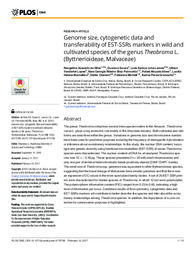Genome size, cytogenetic data and transferability of EST-SSRs markers in wild and cultivated species of the genus Theobroma L. (Byttnerioideae, Malvaceae).
Genome size, cytogenetic data and transferability of EST-SSRs markers in wild and cultivated species of the genus Theobroma L. (Byttnerioideae, Malvaceae).
Autoria: SILVA, R. A. da; SOUZA, G.; LEMOS, L. S. L.; LOPES, U. V.; PATROCÌNIO, N. G. R. B.; ALVES, R. M.; MARCELLINO, L. H.; CLEMENT, D.; MICHELI, F.; GRAMACHO, K. P.
Resumo: The genus Theobroma comprises several trees species native to the Amazon. Theobroma cacao L. plays a key economic role mainly in the chocolate industry. Both cultivated and wild forms are described within the genus. Variations in genome size and chromosome number have been used for prediction purposes including the frequency of interspecific hybridization or inference about evolutionary relationships. In this study, the nuclear DNA content, karyotype and genetic diversity using functional microsatellites (EST-SSR) of seven Theobroma species were characterized. The nuclear content of DNA for all analyzed Theobroma species was 1C = ~ 0.46 pg. These species presented 2n = 20 with small chromosomes and only one pair of terminal heterochromatic bands positively stained (CMA+/DAPI− bands). The small size of Theobroma ssp. genomes was equivalent to other Byttnerioideae species, suggesting that the basal lineage of Malvaceae have smaller genomes and that there was an expansion of 2C values in the more specialized family clades. A set of 20 EST-SSR primers were characterized for related species of Theobroma, in which 12 loci were polymorphic. The polymorphism information content (PIC) ranged from 0.23 to 0.65, indicating a high level of information per locus. Combined results of flow cytometry, cytogenetic data and EST-SSRs markers will contribute to better describe the species and infer about the evolutionary relationships among Theobroma species. In addition, the importance of a core collection for conservation purposes is highlighted.
Ano de publicação: 2017
Tipo de publicação: Artigo de periódico
Unidade: Embrapa Amazônia Oriental
Palavras-chave: Theobroma, Theobroma Cacao
Observações
1 - Por padrão são exibidas publicações dos últimos 20 anos. Para encontrar publicações mais antigas, configure o filtro ano de publicação, colocando o ano a partir do qual você deseja encontrar publicações. O filtro está na coluna da esquerda na busca acima.
2 - Para ler algumas publicações da Embrapa (apenas as que estão em formato ePub), é necessário ter, no celular ou computador, um desses softwares gratuitos. Sistemas Android: Google Play Livros; IOS: iBooks; Windows e Linux: software Calibre.
Acesse outras publicações
Acesse a Base de Dados da Pesquisa Agropecuária (BDPA) para consultar o acervo completo das bibliotecas da Embrapa.

